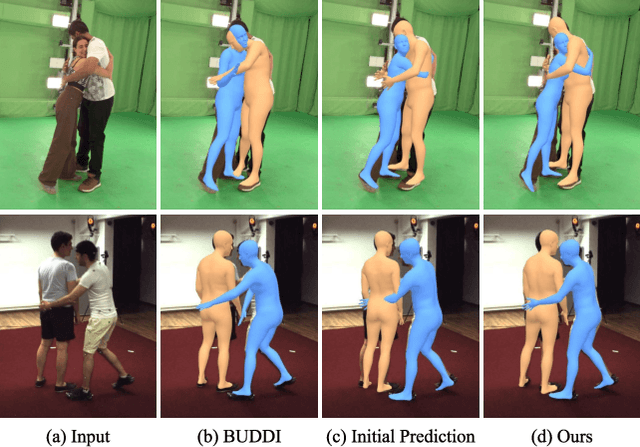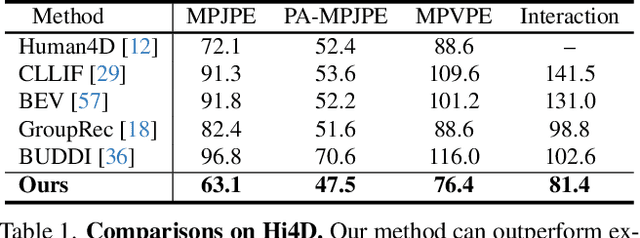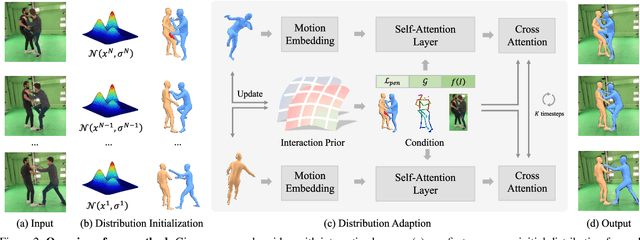Yangang Wang
E-React: Towards Emotionally Controlled Synthesis of Human Reactions
Aug 08, 2025Abstract:Emotion serves as an essential component in daily human interactions. Existing human motion generation frameworks do not consider the impact of emotions, which reduces naturalness and limits their application in interactive tasks, such as human reaction synthesis. In this work, we introduce a novel task: generating diverse reaction motions in response to different emotional cues. However, learning emotion representation from limited motion data and incorporating it into a motion generation framework remains a challenging problem. To address the above obstacles, we introduce a semi-supervised emotion prior in an actor-reactor diffusion model to facilitate emotion-driven reaction synthesis. Specifically, based on the observation that motion clips within a short sequence tend to share the same emotion, we first devise a semi-supervised learning framework to train an emotion prior. With this prior, we further train an actor-reactor diffusion model to generate reactions by considering both spatial interaction and emotional response. Finally, given a motion sequence of an actor, our approach can generate realistic reactions under various emotional conditions. Experimental results demonstrate that our model outperforms existing reaction generation methods. The code and data will be made publicly available at https://ereact.github.io/
Reconstructing Close Human Interaction with Appearance and Proxemics Reasoning
Jul 03, 2025Abstract:Due to visual ambiguities and inter-person occlusions, existing human pose estimation methods cannot recover plausible close interactions from in-the-wild videos. Even state-of-the-art large foundation models~(\eg, SAM) cannot accurately distinguish human semantics in such challenging scenarios. In this work, we find that human appearance can provide a straightforward cue to address these obstacles. Based on this observation, we propose a dual-branch optimization framework to reconstruct accurate interactive motions with plausible body contacts constrained by human appearances, social proxemics, and physical laws. Specifically, we first train a diffusion model to learn the human proxemic behavior and pose prior knowledge. The trained network and two optimizable tensors are then incorporated into a dual-branch optimization framework to reconstruct human motions and appearances. Several constraints based on 3D Gaussians, 2D keypoints, and mesh penetrations are also designed to assist the optimization. With the proxemics prior and diverse constraints, our method is capable of estimating accurate interactions from in-the-wild videos captured in complex environments. We further build a dataset with pseudo ground-truth interaction annotations, which may promote future research on pose estimation and human behavior understanding. Experimental results on several benchmarks demonstrate that our method outperforms existing approaches. The code and data are available at https://www.buzhenhuang.com/works/CloseApp.html.
Boosting Universal LLM Reward Design through the Heuristic Reward Observation Space Evolution
Apr 10, 2025Abstract:Large Language Models (LLMs) are emerging as promising tools for automated reinforcement learning (RL) reward design, owing to their robust capabilities in commonsense reasoning and code generation. By engaging in dialogues with RL agents, LLMs construct a Reward Observation Space (ROS) by selecting relevant environment states and defining their internal operations. However, existing frameworks have not effectively leveraged historical exploration data or manual task descriptions to iteratively evolve this space. In this paper, we propose a novel heuristic framework that enhances LLM-driven reward design by evolving the ROS through a table-based exploration caching mechanism and a text-code reconciliation strategy. Our framework introduces a state execution table, which tracks the historical usage and success rates of environment states, overcoming the Markovian constraint typically found in LLM dialogues and facilitating more effective exploration. Furthermore, we reconcile user-provided task descriptions with expert-defined success criteria using structured prompts, ensuring alignment in reward design objectives. Comprehensive evaluations on benchmark RL tasks demonstrate the effectiveness and stability of the proposed framework. Code and video demos are available at jingjjjjjie.github.io/LLM2Reward.
Transformer-Enhanced Variational Autoencoder for Crystal Structure Prediction
Feb 13, 2025Abstract:Crystal structure forms the foundation for understanding the physical and chemical properties of materials. Generative models have emerged as a new paradigm in crystal structure prediction(CSP), however, accurately capturing key characteristics of crystal structures, such as periodicity and symmetry, remains a significant challenge. In this paper, we propose a Transformer-Enhanced Variational Autoencoder for Crystal Structure Prediction (TransVAE-CSP), who learns the characteristic distribution space of stable materials, enabling both the reconstruction and generation of crystal structures. TransVAE-CSP integrates adaptive distance expansion with irreducible representation to effectively capture the periodicity and symmetry of crystal structures, and the encoder is a transformer network based on an equivariant dot product attention mechanism. Experimental results on the carbon_24, perov_5, and mp_20 datasets demonstrate that TransVAE-CSP outperforms existing methods in structure reconstruction and generation tasks under various modeling metrics, offering a powerful tool for crystal structure design and optimization.
Adapting Human Mesh Recovery with Vision-Language Feedback
Feb 06, 2025



Abstract:Human mesh recovery can be approached using either regression-based or optimization-based methods. Regression models achieve high pose accuracy but struggle with model-to-image alignment due to the lack of explicit 2D-3D correspondences. In contrast, optimization-based methods align 3D models to 2D observations but are prone to local minima and depth ambiguity. In this work, we leverage large vision-language models (VLMs) to generate interactive body part descriptions, which serve as implicit constraints to enhance 3D perception and limit the optimization space. Specifically, we formulate monocular human mesh recovery as a distribution adaptation task by integrating both 2D observations and language descriptions. To bridge the gap between text and 3D pose signals, we first train a text encoder and a pose VQ-VAE, aligning texts to body poses in a shared latent space using contrastive learning. Subsequently, we employ a diffusion-based framework to refine the initial parameters guided by gradients derived from both 2D observations and text descriptions. Finally, the model can produce poses with accurate 3D perception and image consistency. Experimental results on multiple benchmarks validate its effectiveness. The code will be made publicly available.
CrySPAI: A new Crystal Structure Prediction Software Based on Artificial Intelligence
Jan 27, 2025



Abstract:Crystal structure predictions based on the combination of first-principles calculations and machine learning have achieved significant success in materials science. However, most of these approaches are limited to predicting specific systems, which hinders their application to unknown or unexplored domains. In this paper, we present CrySPAI, a crystal structure prediction package developed using artificial intelligence (AI) to predict energetically stable crystal structures of inorganic materials given their chemical compositions. The software consists of three key modules, an evolutionary optimization algorithm (EOA) that searches for all possible crystal structure configurations, density functional theory (DFT) that provides the accurate energy values for these structures, and a deep neural network (DNN) that learns the relationship between crystal structures and their corresponding energies. To optimize the process across these modules, a distributed framework is implemented to parallelize tasks, and an automated workflow has been integrated into CrySPAI for seamless execution. This paper reports the development and implementation of AI AI-based CrySPAI Crystal Prediction Software tool and its unique features.
Simultaneously Recovering Multi-Person Meshes and Multi-View Cameras with Human Semantics
Dec 25, 2024Abstract:Dynamic multi-person mesh recovery has broad applications in sports broadcasting, virtual reality, and video games. However, current multi-view frameworks rely on a time-consuming camera calibration procedure. In this work, we focus on multi-person motion capture with uncalibrated cameras, which mainly faces two challenges: one is that inter-person interactions and occlusions introduce inherent ambiguities for both camera calibration and motion capture; the other is that a lack of dense correspondences can be used to constrain sparse camera geometries in a dynamic multi-person scene. Our key idea is to incorporate motion prior knowledge to simultaneously estimate camera parameters and human meshes from noisy human semantics. We first utilize human information from 2D images to initialize intrinsic and extrinsic parameters. Thus, the approach does not rely on any other calibration tools or background features. Then, a pose-geometry consistency is introduced to associate the detected humans from different views. Finally, a latent motion prior is proposed to refine the camera parameters and human motions. Experimental results show that accurate camera parameters and human motions can be obtained through a one-step reconstruction. The code are publicly available at~\url{https://github.com/boycehbz/DMMR}.
TSdetector: Temporal-Spatial Self-correction Collaborative Learning for Colonoscopy Video Detection
Sep 30, 2024



Abstract:CNN-based object detection models that strike a balance between performance and speed have been gradually used in polyp detection tasks. Nevertheless, accurately locating polyps within complex colonoscopy video scenes remains challenging since existing methods ignore two key issues: intra-sequence distribution heterogeneity and precision-confidence discrepancy. To address these challenges, we propose a novel Temporal-Spatial self-correction detector (TSdetector), which first integrates temporal-level consistency learning and spatial-level reliability learning to detect objects continuously. Technically, we first propose a global temporal-aware convolution, assembling the preceding information to dynamically guide the current convolution kernel to focus on global features between sequences. In addition, we designed a hierarchical queue integration mechanism to combine multi-temporal features through a progressive accumulation manner, fully leveraging contextual consistency information together with retaining long-sequence-dependency features. Meanwhile, at the spatial level, we advance a position-aware clustering to explore the spatial relationships among candidate boxes for recalibrating prediction confidence adaptively, thus eliminating redundant bounding boxes efficiently. The experimental results on three publicly available polyp video dataset show that TSdetector achieves the highest polyp detection rate and outperforms other state-of-the-art methods. The code can be available at https://github.com/soleilssss/TSdetector.
Closely Interactive Human Reconstruction with Proxemics and Physics-Guided Adaption
Apr 17, 2024



Abstract:Existing multi-person human reconstruction approaches mainly focus on recovering accurate poses or avoiding penetration, but overlook the modeling of close interactions. In this work, we tackle the task of reconstructing closely interactive humans from a monocular video. The main challenge of this task comes from insufficient visual information caused by depth ambiguity and severe inter-person occlusion. In view of this, we propose to leverage knowledge from proxemic behavior and physics to compensate the lack of visual information. This is based on the observation that human interaction has specific patterns following the social proxemics. Specifically, we first design a latent representation based on Vector Quantised-Variational AutoEncoder (VQ-VAE) to model human interaction. A proxemics and physics guided diffusion model is then introduced to denoise the initial distribution. We design the diffusion model as dual branch with each branch representing one individual such that the interaction can be modeled via cross attention. With the learned priors of VQ-VAE and physical constraint as the additional information, our proposed approach is capable of estimating accurate poses that are also proxemics and physics plausible. Experimental results on Hi4D, 3DPW, and CHI3D demonstrate that our method outperforms existing approaches. The code is available at \url{https://github.com/boycehbz/HumanInteraction}.
Knowledge NeRF: Few-shot Novel View Synthesis for Dynamic Articulated Objects
Apr 07, 2024



Abstract:We present Knowledge NeRF to synthesize novel views for dynamic scenes. Reconstructing dynamic 3D scenes from few sparse views and rendering them from arbitrary perspectives is a challenging problem with applications in various domains. Previous dynamic NeRF methods learn the deformation of articulated objects from monocular videos. However, qualities of their reconstructed scenes are limited. To clearly reconstruct dynamic scenes, we propose a new framework by considering two frames at a time.We pretrain a NeRF model for an articulated object.When articulated objects moves, Knowledge NeRF learns to generate novel views at the new state by incorporating past knowledge in the pretrained NeRF model with minimal observations in the present state. We propose a projection module to adapt NeRF for dynamic scenes, learning the correspondence between pretrained knowledge base and current states. Experimental results demonstrate the effectiveness of our method in reconstructing dynamic 3D scenes with 5 input images in one state. Knowledge NeRF is a new pipeline and promising solution for novel view synthesis in dynamic articulated objects. The data and implementation are publicly available at https://github.com/RussRobin/Knowledge_NeRF.
 Add to Chrome
Add to Chrome Add to Firefox
Add to Firefox Add to Edge
Add to Edge